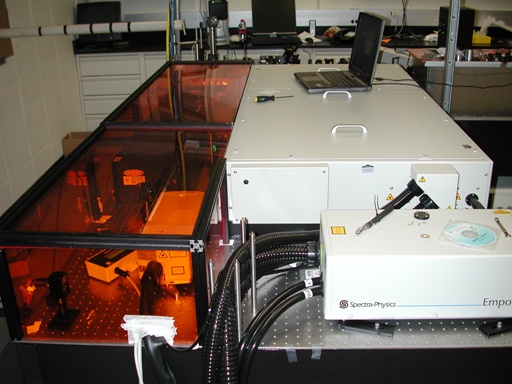Research: Difference between revisions
No edit summary |
|||
| Line 11: | Line 11: | ||
== Time-Domain Terahertz spectroscopy == | == Time-Domain Terahertz spectroscopy == | ||
THz radiation is the wavelength range of .020-1mm and can have pulse lengths as fast as 30fs. While these wavelengths are relatively long, it is the spectral region of low frequency molecular vibrations and rotations, making this a useful range for molecular spectroscopy. Producing pulsed THz radiation can easily accomplished by rapidaly accelerating charged particles. This is typcially accomplished via ultrafast excitation of semiconductors or the rapid generation of a dense electron plasma. We have produced and measured coherent THz radiation from a dense laser-driven plasma in a copper target. This radiation is a direct measurement of the electron dynamics within the plasma, providing a novel method to performing laser-plasma diagnostics. | |||
== Time-Domain Optical spectroscopy == | == Time-Domain Optical spectroscopy == | ||
Revision as of 15:55, 26 June 2012
The DeCamp lab uses ultrafast radiation to study the sub-picosecond dynamics of complex systems. This ranges from the structural dynamics of crystalline systems to molecular dynamics in solution. The DeCamp Lab is developing several time-domain spectroscopic tools to fulfill these goals, including time-resolved x-ray scattering, time-domain THz spectroscopy, and time-domain optical spectroscopy.
Laser system
The backbone of any ultrafast spectroscopy lab is the laser source. The DeCamp lab has a 1kHz Spectra-Physics Spitfire XP amplifier seeded by a KMLabs Oscillator. The laser generates 3mJ, sub-40fs laser pulses for ultrafast spectroscopy. The laser output has been upgraded to produce 5+mJ at 1kHz by the construction of a home built, LN2 cooled multipass power amplifier. Using modest focusing, this laser is able to generate optical fields greater than 10^{17}\frac{W}{cm^2}.
Time-resolved X-ray diffraction
Time-Domain Terahertz spectroscopy
THz radiation is the wavelength range of .020-1mm and can have pulse lengths as fast as 30fs. While these wavelengths are relatively long, it is the spectral region of low frequency molecular vibrations and rotations, making this a useful range for molecular spectroscopy. Producing pulsed THz radiation can easily accomplished by rapidaly accelerating charged particles. This is typcially accomplished via ultrafast excitation of semiconductors or the rapid generation of a dense electron plasma. We have produced and measured coherent THz radiation from a dense laser-driven plasma in a copper target. This radiation is a direct measurement of the electron dynamics within the plasma, providing a novel method to performing laser-plasma diagnostics.
